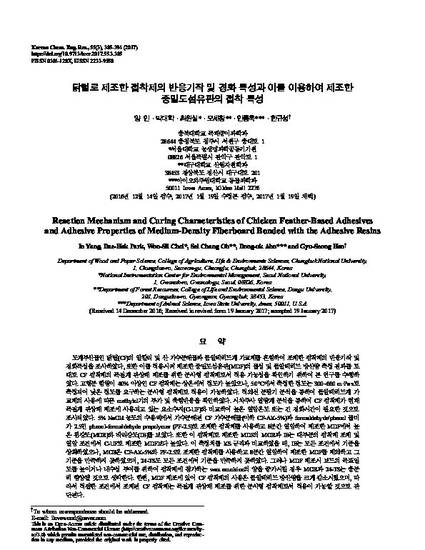
In this study, reaction mechanism and curing characteristics of adhesives formulated with NaOH- and H2SO4-hydrolyzed chicken feather (CF) and formaldehyde-based crosslinkers were investigated by FT-IR and DSC. In addition, adhesive properties and formaldehyde emission of medium-density fiberboards (MDF) applied with the adhesives were measured. CF-based adhesives having a solid content of 40% and over were very viscous at 25 °C, but the viscosity reduced to 300~660 m·Pa·s at 50 °C. Consequently, the adhesives could be used as a sprayable resin. Through the FT-IR spectra of liquid and cured CF-based adhesives, addition reaction of methylol group and condensation reaction between the functional groups with the use of formaldehyde-based crosslinkers were identified. From the analysis of DSC, it was elucidated for CF-based adhesives to require a higher pressing temperature or longer pressing time comparing to commercial urea-formaldehyde (C-UF) resin. MDF bonded with CF-based adhesives, which was formulated with 5% NaOH-hydrolyzed CF (CF-AK-5%) and PF of formaldehyde to phenol mole ratio of 2.5 (PF-2.5), and pressed for 8 min had higher MOR and IB than those with other CF-based adhesives. MOR and IB of MDF bonded with the CFbased adhesives regardless of formulation type and pressing time were higher than those with C-UF resin. When the values compared with the minimum requirements of KS standard, IB exceeded the KS standard in all formulations and pressing time, but MOR of only MDF bonded with CF-AK-5% and PF-2.5 and pressed for 8 min satisfied the KS standard. What was worse, 24-TS of MDF bonded with all CF-based adhesives did not satisfied the KS standard. However, MOR and 24-TS can be improved by increasing the target density of MDF or the amount of wax emulsion, which is added to improve the water resistance of MDF. Importantly, the use of CF-based adhesives decreased greatly the formaldehyde emission. Based on the results, we reached the conclusion that CF-based adhesives formulated under proper conditions had a potential as a sprayable resin for the production of wood panels.
Available at: http://works.bepress.com/dong_ahn/179/

This article is published as Yang, In, Dae-Hak Park, Won-Sil Choi, Sei Chang Oh, Dong-uk Ahn, and Gyu-Seong Han. "Reaction mechanism and curing characteristics of chicken feather-based adhesives and adhesive properties of medium-density fiberboard bonded with the adhesive resins." Korean Chemical Engineering Research 55, no. 3 (2017): 385-394. doi:10.9713/kcer.2017.55.3.385.